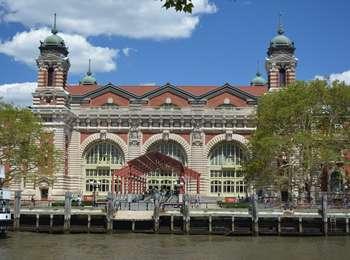Last updated: April 17, 2023
Place
Ellis Architectural Highlights

Historical/Interpretive Information/Exhibits
Main Immigration Building - front elevation: The monumental Main Immigration Building opened at the end of 1900 to replace the original wooden station that burned in 1897. The New York firm of Boring & Tilton was chosen as the architects after an invitational competition, only the second held under the Tarsney Act of 1893 allowing private architects to compete for government commissions. Both principal architects had studied at the École des Beaux-Arts in Paris.
Copper Tops the Towers
The towers are topped by ornate copper domes that were carefully restored by the National Park Service. The openings are filled with a terracotta screen that facilitates air flow.
Top of a Tower
The Main Immigration Building was designed with four corner towers featuring ornate decoration to create an impressive view from across the water. The large scale of the brackets, acroterion ( a pedestal placed on a pediment to support a statue or other ornamentation,) and other decorative features was intended to make them legible from a distance.
Entrance to Northeast Tower
The robust limestone quoins and heavy Classical entablature at the entrance to the northeast tower of the Main Immigration Building are characteristic of the Beaux-Arts Classical approach employed by Boring & Tilton.
Corbelled Bricks
The corbelled bricks visible in this stairwell help support the weight of the tower above.
Guastavino Ceiling Vault
The impressive vaulted space of the Great Hall was rebuilt using Guastavino structural tile. The Guastavino Fireproof Construction Company developed their patented system of interlocking tiles and thin layers of mortar to safely and relatively inexpensively create grand public spaces throughout the United States during the late 19th and early 20th centuries. The original plaster vault was damaged by the Black Tom Wharf explosion in 1916.
Main Hospital Complex
The main hospital was built in three stages on landfill designated "Island 2." The first section (right) was designed by Boring & Tilton and opened in 1901. Government architects with the Office of the Supervising Architect of the Treasury James Knox Taylor designed the Administration Building (center) and third section. The main hospital was completed by 1909 and presents a unified Georgian Revival appearance.
Have you considered a hard hat tour? Guided 90-minute tours will take you to select areas of the 750-bed Ellis Island Hospital. Visit the Laundry Building, with much of its original equipment still in place, where over 3000 pieces of laundry were washed and sanitized daily. The tour will also take you to the infectious and contagious disease wards, kitchen, staff housing, autopsy room and more. Stop at the Save Ellis Island Information Desk (Ellis Ground Floor Baggage Room) to learn more. Learn more about Save Ellis Island and their ongoing efforts to preserve the South Side of Ellis Island on their website www.saveellisisland.org
New Ferry Building
FDR's New Deal funding was used to build a new Art Deco Ferry Building in 1934-36. The brick and limestone structure replaced the metal-clad wooden ferry building at the end of the ferry slip between Islands 1 and 2.
Top of the New Ferry Building
The New Ferry Building offers stylish Art Deco details such as bas relief limestone panels and a lead-sheathed tower decorated with a chevron motif and dramatic eagles perched at each corner. New York architect Chester Aldrich served as consulting architect, with the Public Buildings Branch of the Department of the Treasury, led by Louis A. Simon, as supervising architects.
